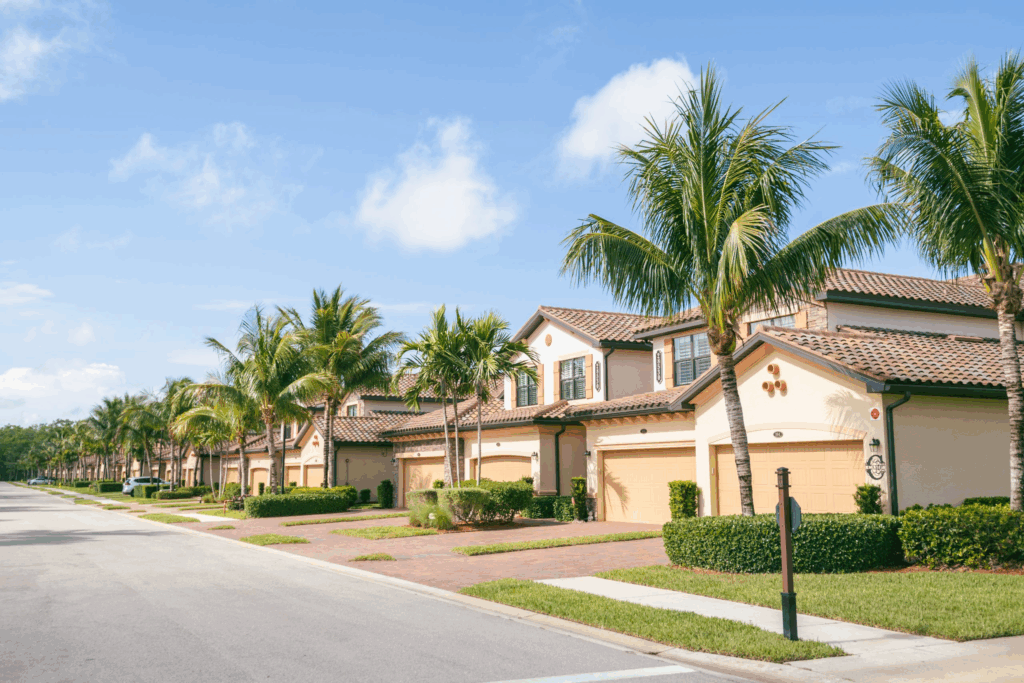Florida’s population is booming, and families are flocking south to make the Sunshine State their home. The state has been one of the nation’s fastest-growing, thanks to a mix of year-round sunshine, affordable living (by some measures), no state income tax, and expanding job opportunities.
For example, between 2022 and 2023 the Orlando-Kissimmee area gained about 54,900 new residents, and the Tampa-St. Petersburg area grew by roughly 51,600 people.
These metro areas now rank among the U.S.’s top population gainers, even as cities like Miami–Fort Lauderdale–West Palm Beach added over 43,000 newcomers in the same period. Whether it’s the lure of warm weather or economic opportunity, the trend is clear: more families are choosing Florida, from bustling cities to quieter coastal communities. With a little preparation and the right information, you can make the move work for your family, too.
Sunshine and Outdoor Lifestyle
One of Florida’s biggest draws is its sunny climate and outdoor lifestyle. With an average of 237 sunny days per year and mild winters, families enjoy year-round activities like beach outings, boating, hiking, and cycling.
Kids can play outside most of the year, and families often gather for picnics, swim in local pools, or celebrate holidays outdoors. This active lifestyle also brings notable health benefits.
Popular destinations like Clearwater Beach and Melbourne Beach are ideal for weekend escapes, while natural treasures like the Everglades, Ocala National Forest, and freshwater springs offer endless family adventures. Many neighborhoods feature lakes, playgrounds, bike paths, and organized youth sports, encouraging healthy habits.
Even Florida’s cities support active living, with pedestrian-friendly areas like Tampa’s Riverwalk and Jacksonville’s Riverfront. Professional sports events, parks, and community events keep residents engaged throughout the year. If your family enjoys sunshine and staying active, Florida is hard to beat.
Tax Benefits and Cost of Living
Florida’s tax structure is one of the most resident-friendly in the U.S. There’s no state or local personal income tax, which means your paycheck goes further—especially compared to high-tax states like New York or New Jersey. Retirees and families benefit from tax-free Social Security and pension income, and there are no state taxes on capital gains, dividends, estates, or inheritances.
Property taxes are moderate, with an average effective rate of about 0.79%, and homestead exemptions in many counties help lower costs even more. Combined state and local sales tax hovers around 7%, making everyday expenses manageable.
Overall, Florida offers an attractive cost of living. Housing costs, in particular, stand out—average home prices in cities like Tampa are under $380K, far below prices in the Northeast or West Coast.
Upscale areas like Palm Beach County are pricier, averaging around $659K, but reflect a premium lifestyle. Utilities, gas, and groceries are generally close to or below the national average. The result: many families find they can afford more space and enjoy greater financial flexibility for travel, savings, or education.
Jobs and Economic Opportunities

Florida’s economy is thriving, offering more than just sunshine and beaches—it’s a hub of job growth and opportunity. In 2024, Orlando led all large U.S. metro areas in job growth, adding an estimated 37,500 jobs. While tourism remains strong, the region’s economy is diversifying with growth in healthcare (AdventHealth, Orlando Health), finance (BNY Mellon), and tech (UCF’s corridor, Lockheed Martin, biotech startups).
Tampa Bay is booming as well. By late 2023, the metro area surpassed 1.5 million jobs. Education and health services grew 6.6% year-over-year, adding 14,800 jobs. Professional services, trade, and transportation are also major sectors. Employers range from financial firms and tech startups to a busy port. Institutions like the University of South Florida help feed local talent.
North Florida, particularly Jacksonville, has seen a surge in both population and employment. Over 14,000 people moved to the city in a year, and The Wall Street Journal ranked it the second-hottest job market in the U.S. Its economy includes finance (Fidelity, CSX, Bank of America), logistics (FedEx, Port of Jacksonville), healthcare, and growing tech firms. Lower living costs also attract businesses seeking affordable labor.
Across the state, families benefit from a diverse economy spanning healthcare, aerospace, education, defense, hospitality, and finance.
The Space Coast draws aerospace and defense firms, while cities like Miami support film, tourism, and international trade. Florida’s job growth rate consistently outpaces the national average, making it an appealing destination for families seeking both opportunity and affordability. Whether relocating within a company or starting fresh, Florida’s vibrant job market offers options for every career stage.
Education and Family-Friendly Amenities
Florida places a strong emphasis on education, with many top-rated public schools and universities. Districts like Seminole, Sarasota, and St. Johns counties frequently rank among the best in the state. Florida also supports school choice, offering charter schools, magnet programs, and helpful resources like GreatSchools.org to help families compare options.
For higher education, Florida is home to well-regarded institutions. Florida State University and the University of Florida are nationally ranked, while UCF, the University of Miami, Florida Atlantic, and USF offer a wide range of academic programs and career pipelines. These schools also enrich local communities through events, lectures, and family programs.
Recreation is another perk of Florida life. Theme parks like Disney World and Universal are major draws for Central Florida families, while science centers, zoos, and aquariums (like Clearwater Marine Aquarium or the Kennedy Space Center) offer fun and educational outings. Cultural hubs in Miami, Tampa, and St. Petersburg feature museums, festivals, and art scenes that families can enjoy year-round.
Florida communities often emphasize family life, safety, and outdoor living. Many neighborhoods are suburban and kid-friendly, with parks, sports leagues, and school-centered events. Places like Winter Park and Lakewood Ranch are designed with families in mind. With strong community involvement—PTAs, local festivals, and youth programs—many families find it easy to settle in and feel at home in the Sunshine State.
Top Cities and Regional Highlights

Florida offers a range of living experiences depending on the region—each with its own housing market, lifestyle, and job opportunities. Here’s a quick look at key areas for families:
- Tampa Bay (Hillsborough/Pinellas Counties): This Gulf Coast region blends urban and suburban life. Tampa boasts a growing downtown, tech startups, and the Ybor City entertainment district, while nearby St. Petersburg and Clearwater offer stunning beaches. Housing is relatively affordable, with average home values around $379K. Suburbs like Carrollwood, Land O’Lakes, and Seminole are popular with families for their strong schools. Major employers include Tampa General, Moffitt Cancer Center, BB&T, and Citi. The area also has vibrant sports and events scenes, including the Gasparilla Festival and teams like the Buccaneers, Lightning, and Rays.
- Orlando Area (Orange/Osceola Counties): Famous for theme parks, Orlando is also a rapidly growing metro area. In 2024, it added over 37,500 jobs, driven by healthcare (AdventHealth, Orlando Health) and tech firms (UCF and new startups). Median home prices range from $350K–$400K, slightly above Tampa but still affordable. Suburban areas like Lake Nona and Winter Park are family favorites. Top-rated schools in Seminole and Osceola counties, along with charter and magnet programs, provide solid education choices. Families enjoy attractions, sports, and community events year-round.
- Jacksonville & Northeast Florida: Florida’s largest city by area, Jacksonville offers a quieter lifestyle and some of the most affordable housing in the state—under $400K in most areas. With over 14,000 new residents last year, Jacksonville is growing thanks to jobs in logistics (Port of Jacksonville), finance (Fidelity, Black Knight), and healthcare. Outdoor perks include Amelia Island, Jacksonville Beach, and the St. Johns River. St. Johns County, just south of the city, is popular for families due to its highly rated schools.
- Palm Beach County (West Palm Beach, Boca Raton, Jupiter) – This Atlantic coast region is more upscale, with median single-family homes around $659K. Despite the higher cost, it’s family-friendly in areas like Wellington and Boca Raton, which offer top-rated schools and suburban living. Beaches like Palm Beach Island and Juno Beach, plus attractions such as the Palm Beach Zoo and Science Center, offer family recreation. The local economy centers on finance, healthcare, and growing tech startups. Many families relocating from high-cost states still find long-term savings here thanks to Florida’s no state income tax and relatively modest property taxes.
Each region has its own flavor: Jacksonville is more laid-back, Orlando/Tampa offer energy and family attractions, and Palm Beach delivers luxury and culture. Families should weigh housing costs, school options, and local amenities when choosing the right fit in Florida.
Planning Your Family’s Move
Relocating to Florida can be exciting—but requires smart planning. Here are key tips to help your family transition smoothly:
- Budget Carefully – Moving comes with upfront costs: movers, travel, deposits, and possibly temporary housing. Don’t forget to research the cost of living in your new area. Housing, insurance, and taxes vary—Tampa Bay, for instance, generally has lower property taxes and insurance rates than South Florida. Factor in both one-time moving costs and your new monthly budget.
- Start Your Home Search Early – Whether buying or renting, start early—popular neighborhoods and school zones go fast. Work with a local real estate agent or use trusted online listings. If you’re buying, consider connecting with a Florida-based agent who is familiar with the local market. Look for places with strong schools, a manageable commute, and family-friendly amenities. For example, exploring Palm Beach County homes for sale can give you a clearer idea of available options and pricing.
- Explore Construction Options – If you can’t find a move-in-ready home that fits your needs, building your own might be worth considering. Florida offers many new developments and custom home opportunities. Working with a professional who specializes in construction management can help ensure your project stays on budget and schedule. This route gives families more control over layout, materials, and long-term value.
- Choose the Right Community – Schools, safety, commute times, and amenities matter. Use tools like GreatSchools.org or Niche.com to compare districts. Check for parks, libraries, pediatricians, and daycare centers. Visit local community centers or churches and join neighborhood groups online (like Nextdoor or Facebook) to ask about daily life in the area.
- Prepare for Florida’s Weather – While Florida offers sunshine, it also comes with hurricanes and humidity. Make sure your new home has proper protection like storm shutters or impact windows, and consider flood insurance in coastal areas. Create an emergency plan, including evacuation routes and supplies. Investing in weather-appropriate clothing and a home ready for storms provides both safety and peace of mind.
- Build a Support Network – Adjusting to a new place is easier when you connect with others. Join local parenting groups, PTAs, sports leagues, or church communities. Many areas have welcome events or block parties. Taking your kids to the library, pool, or local playground helps build friendships and feel more at home. As one relocation blog advises, “building a network helps families feel rooted and supported faster.”
By taking these steps – budgeting, researching, and plugging into the local community – you set your family up for a smooth transition. The key is to plan ahead and be flexible.
Conclusion
Florida offers families a special combination of sunny weather, no income tax, growing job markets, and a wide range of living options from beaches to urban centers. Cities like Tampa, Orlando, Jacksonville, and West Palm Beach each have different strengths, but all share the Sunshine State’s big advantages.
If your family is considering the move, use the tips above to research housing, plan your budget, and connect with the community. With the right preparation, you can enjoy what Florida has to offer – from backyard barbecues almost year-round to new career opportunities – and make the Sunshine State truly feel like home.

